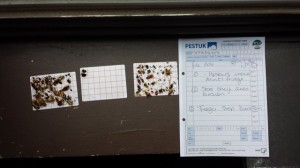Cockroaches – Where You Find Them and Why
In Pests
Cockroaches – Where You Find Them and Why
Cockroaches are recognisable by their long, whip like antennae, their oval bodies. They are mainly nocturnal and nest in areas of high heat, usually kitchens or boiler rooms. PESTUK technicians and staff are commonly asked about cockroaches where you find them and why they are there. Cockroaches thrive around heating pipes, and boiler rooms of large buildings such as hospitals, hotels and restaurant kitchens. They can be found in residential properties as well, commonly blocks of flats. Cockroach infestations can start through incoming laundry, raw materials, in crates and packaging, or arise as the insects enter the building via drains or refuse chutes.
 Cockroaches
Cockroaches
They have been pests in domestic dwellings for centuries and are difficult to eradicate, because of their secretive and nocturnal habits. You may see them occasionally during the daytime, and destruction of these will do little to reduce the actual population. They live during the day in cracks and crevices, behind tiles, in refrigerator motors, junction boxes and even light fittings. If cockroaches are seen regularly during the day then the infestation is usually quite serious as they are nocturnal. The cockroaches to be encountered in the UK are German and the Oriental cockroaches.
German Cockroach
The adults are 10-15 mm long, yellowish-brown with wings on both sexes, but they are never used. They are excellent climbers on both smooth and rough surfaces. The female of the species produces 4-8 egg capsules at monthly intervals. Each capsule contains about 30 eggs, which the female carries with her until just before hatching, which takes 2-4 weeks. Meaning that a population can rapidly increase if not noticed or dealt with effectively.
Asian Cockroach
Adults are 20-24 mm long, dark brown, nearly black. Wings of male cover two-thirds of abdomen. Wings of the females are vestigial and cannot be used for flight. Both can climb rough but not smooth surfaces. The female produces 5 egg capsules at monthly intervals. The thick walled resistant capsules, 12mm in length, each contain up to 16 eggs and are cemented to the substrate in the vicinity of a food supply, and may be covered over with debris. Nymphs emerge 6-12 weeks later and progress through 7-10 moults before reaching maturity, a process which takes from 10 months up to 2 years depending upon temperatures and food supply. Adults will live approximately 4.5 months at 25C. They are largely being replaced by the German, which is a better climber and faster breeder.
Treatment of Cockroaches
Before the technician arrives we recommend that you clean under and in cookers, fridges etc. All areas up and down (cockroaches can climb) need to be cleaned and de greased thoroughly. You should also contact your neighbors or any building connected to yours to see if they have a problem. Treatments of large communal type buildings will only work if the whole building is treated at the same time.
The cockroach infestation will have been baited using a bait called Advion Cockroach Gel Bait which contains Indoxacarb or treated with an insecticide spray. All insecticides are biodegradable, almost odourless, non tainting and do not corrode or stain.
PESTUK are full members of the BPCA, the governing body for pest control in the UK. Using a BPCA member company ensures you have a qualified, fully insured company treating your pest problem.

PESTUK have offices in Oxford, Guildford, Enfield, Shepperton, Wantage, St. Albans, Salisbury, St Albans and Enfield.
Call us on 0330 100 2811 to book an appointment regarding Cockroaches where you’ll find them and why, or any other pest problem you may have.

